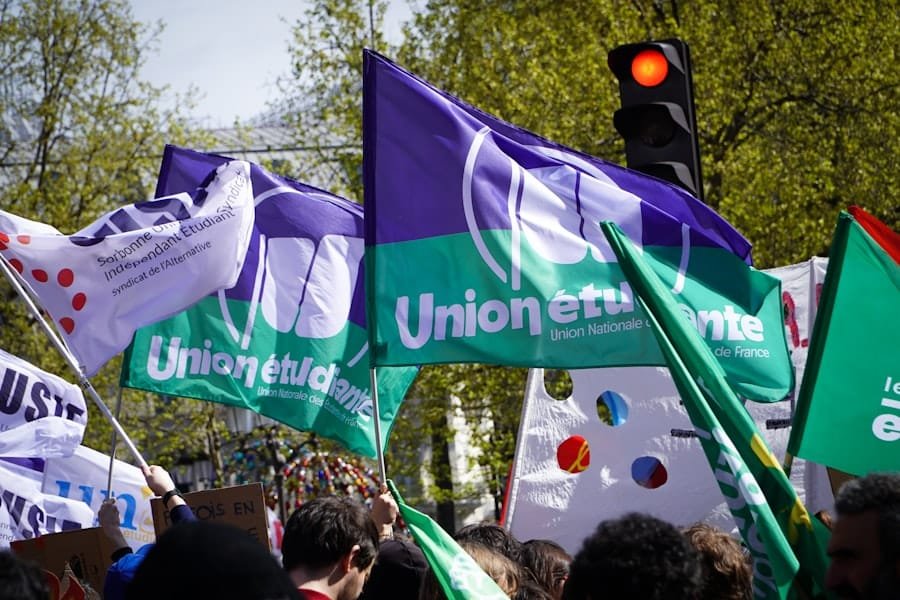Labor unions have a significant history that traces back to the Industrial Revolution of the 18th and 19th centuries. During this period of rapid industrialization, workers faced challenging working conditions, extended hours, and low wages. In response, they began organizing into unions to advocate for improved treatment and compensation.
The National Labor Union, established in 1866, was one of the earliest and most influential labor organizations. It aimed to enhance working conditions and reduce the workday to eight hours. Although the National Labor Union eventually dissolved, it established a foundation for future labor movements.
The late 19th and early 20th centuries witnessed the emergence of powerful labor unions such as the American Federation of Labor (AFL) and the Congress of Industrial Organizations (CIO). These organizations campaigned for workers’ rights, achieving notable successes including the implementation of the eight-hour workday, workplace safety regulations, and the right to collective bargaining. Throughout the 20th century, the labor movement continued to expand its influence, with unions playing a crucial role in securing fair wages, benefits, and workplace protections for millions of workers.
The history of labor unions has been characterized by both achievements and challenges, but their impact on shaping modern labor laws and workplace conditions has been substantial.
Key Takeaways
- Labor unions have a long history of advocating for workers’ rights and fair treatment in the workplace.
- Labor unions play a crucial role in negotiating fair wages and benefits for workers, ensuring they receive fair compensation for their work.
- Labor unions have had a significant impact on improving workplace conditions, such as safety standards and working hours, for their members.
- Collective bargaining is a key function of labor unions, allowing workers to negotiate with employers as a unified group to achieve better working conditions and wages.
- Labor unions face challenges in today’s workplace, including anti-union sentiment, globalization, and the rise of the gig economy, which can make it difficult to organize and advocate for workers’ rights.
The Importance of Labor Unions in Wage Negotiations
Fair Share of Profits
Through collective bargaining, unions can ensure that workers receive a fair share of the profits generated by their labor. This is particularly important in industries where workers may be vulnerable to exploitation or where there is a significant power imbalance between employees and employers.
Addressing Income Inequality
Labor unions help to address income inequality by advocating for living wages that enable workers to support themselves and their families. By standing together, workers can demand fair compensation that reflects their contributions to the success of the company.
Promoting Economic Justice
In this way, labor unions are instrumental in promoting economic justice and ensuring that workers are able to share in the prosperity they help create. By negotiating fair wages and benefits, unions help to create a more equitable distribution of wealth and promote a more just society.
The Impact of Labor Unions on Workplace Conditions

In addition to wage negotiations, labor unions have a significant impact on improving workplace conditions for employees. Through collective action, unions have been instrumental in establishing regulations and standards that protect workers from unsafe or unhealthy environments. This includes advocating for measures such as proper ventilation, ergonomic workstations, and safety protocols to prevent accidents and injuries on the job.
Furthermore, labor unions have been at the forefront of promoting work-life balance by advocating for reasonable working hours, paid leave, and flexible scheduling options. By addressing these issues, unions contribute to creating a healthier and more sustainable work environment that prioritizes the well-being of employees. This not only benefits individual workers but also has a positive impact on overall productivity and morale within the workplace.
Moreover, labor unions have historically played a key role in combating discrimination and promoting diversity in the workplace. By advocating for equal treatment and opportunities for all workers, regardless of race, gender, or background, unions have helped to create more inclusive and equitable workplaces. This has led to greater representation and advancement opportunities for marginalized groups, contributing to a more diverse and dynamic workforce.
The Role of Collective Bargaining in Labor Unions
Collective bargaining is a cornerstone of labor unions’ efforts to secure fair wages and working conditions for their members. Through this process, unions negotiate with employers on behalf of their members to reach agreements that address issues such as wages, benefits, hours, and workplace policies. Collective bargaining allows workers to have a voice in shaping their employment terms and ensures that their interests are represented at the bargaining table.
By engaging in collective bargaining, labor unions are able to leverage the collective power of their members to achieve better outcomes than individual workers could on their own. This process helps to level the playing field between employees and employers, particularly in industries where there may be a significant power imbalance. Through negotiation and compromise, collective bargaining can lead to mutually beneficial agreements that address the needs of both workers and employers.
Furthermore, collective bargaining promotes stability and predictability in labor relations by establishing clear guidelines for employment terms. This can help to prevent disputes and conflicts in the workplace by providing a framework for addressing issues such as grievances, disciplinary actions, and layoffs. By establishing clear expectations through collective bargaining agreements, both workers and employers can operate within a more transparent and harmonious work environment.
Challenges Faced by Labor Unions in Today’s Workplace
Despite their historical significance, labor unions face numerous challenges in today’s workplace. One of the primary obstacles is the decline in union membership, which has been attributed to factors such as globalization, automation, and anti-union legislation. As a result, unions have seen a decrease in their ability to influence wage negotiations and workplace conditions across various industries.
Additionally, some employers have engaged in aggressive tactics to discourage unionization efforts, including intimidation, retaliation against union supporters, and anti-union propaganda. This has made it increasingly difficult for workers to exercise their right to organize and collectively bargain for better treatment and pay. Furthermore, the gig economy and the rise of independent contractors have presented new challenges for traditional labor unions, as these workers may not have the same legal protections or opportunities for collective action.
Moreover, shifts in public opinion and political dynamics have also posed challenges for labor unions. In some cases, there has been a lack of support for organized labor at both the legislative and societal levels. This has made it more difficult for unions to advocate for policies that benefit workers and advance their interests in today’s rapidly changing economy.
The Future of Labor Unions in Wage Negotiations and Workplace Conditions

Reaching New Sectors of the Workforce
This may involve reaching out to new sectors of the workforce, such as gig economy workers or freelancers, and finding new ways to advocate for their rights and interests.
Collaboration with Social Movements
Furthermore, there is potential for collaboration between labor unions and other social movements to address broader issues such as economic inequality, racial justice, and climate change. By forming alliances with other advocacy groups, unions can amplify their impact and work towards creating more equitable and sustainable workplaces for all workers.
Leveraging Technological Advancements
Additionally, technological advancements present new opportunities for organizing and mobilizing workers on a larger scale. Digital platforms and social media can be used to connect with potential union members, share information about workplace rights, and coordinate collective actions more efficiently. By embracing these tools, labor unions can expand their reach and engage with a new generation of workers who are seeking better working conditions and fair compensation.
Successful Examples of Labor Unions Improving Wage Negotiations and Workplace Conditions
Despite the challenges they face, there have been successful examples of labor unions making significant strides in improving wage negotiations and workplace conditions. For instance, the Fight for $15 movement has mobilized fast-food workers and other low-wage employees to demand higher minimum wages across the United States. Through protests, strikes, and advocacy efforts, this movement has succeeded in raising awareness about the need for living wages and has led to legislative changes in several cities and states.
In addition, some labor unions have successfully negotiated innovative agreements with employers that address modern workplace issues such as remote work arrangements, job security in the face of automation, and mental health support for employees. These agreements demonstrate that unions can adapt to changing work environments while still advocating for fair treatment and compensation for their members. Furthermore, there have been successful efforts to organize workers in new industries such as tech companies and digital media outlets.
These initiatives have led to improved working conditions, better pay, and increased job security for employees who may not have traditionally been represented by labor unions. In conclusion, while labor unions face significant challenges in today’s workplace, they continue to play a vital role in advocating for fair wages and improving workplace conditions for workers across various industries. By leveraging collective bargaining power, adapting to new economic realities, and forming alliances with other social movements, labor unions can continue to shape the future of work in ways that benefit all workers.
As history has shown us, organized labor remains a powerful force for positive change in society.
If you’re interested in learning more about the impact of labor unions on workplace conditions, you may want to check out the article “The Pros and Cons of Labor Unions” on The Econosphere. This article delves into the various ways in which labor unions can influence wages, benefits, and working conditions, providing a comprehensive overview of the topic.
FAQs
What is the role of labor unions in wage negotiations?
Labor unions play a crucial role in representing the collective interests of workers in negotiating fair wages, benefits, and working conditions with employers. They advocate for better pay and benefits for their members through collective bargaining and often engage in strikes or other forms of industrial action to achieve their goals.
How do labor unions impact workplace conditions?
Labor unions work to improve workplace conditions by negotiating for better health and safety standards, reasonable work hours, and fair treatment of employees. They also advocate for policies that protect workers from discrimination and harassment in the workplace.
What are the benefits of labor unions for workers?
Labor unions provide workers with a collective voice to address workplace issues, negotiate for better wages and benefits, and ensure fair treatment by employers. They also offer support and representation in disputes with management, as well as access to resources such as training and education programs.
Are there any drawbacks to labor unions?
Some critics argue that labor unions can lead to increased labor costs for employers, which may impact job creation and economic competitiveness. Additionally, there are concerns about union corruption and the potential for unions to become too powerful and disruptive in the workplace.








